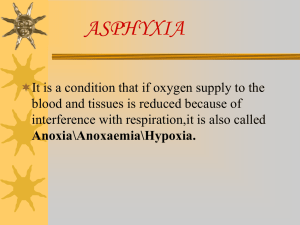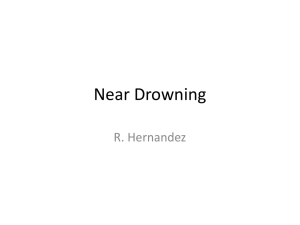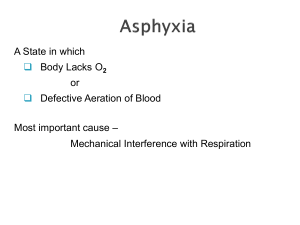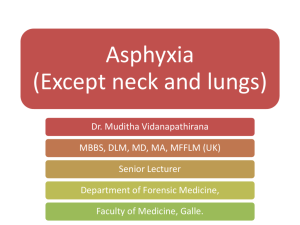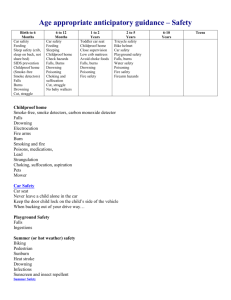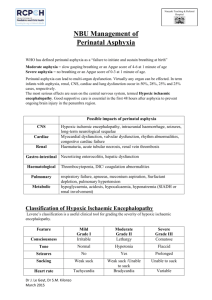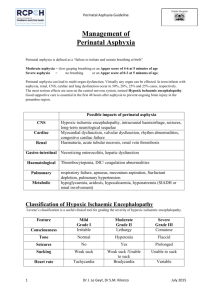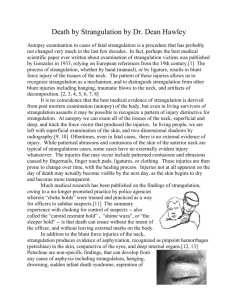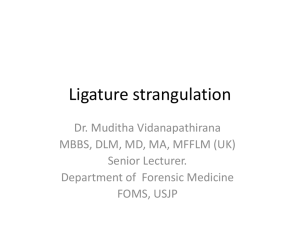FORENSIC PATHOLOGY
advertisement
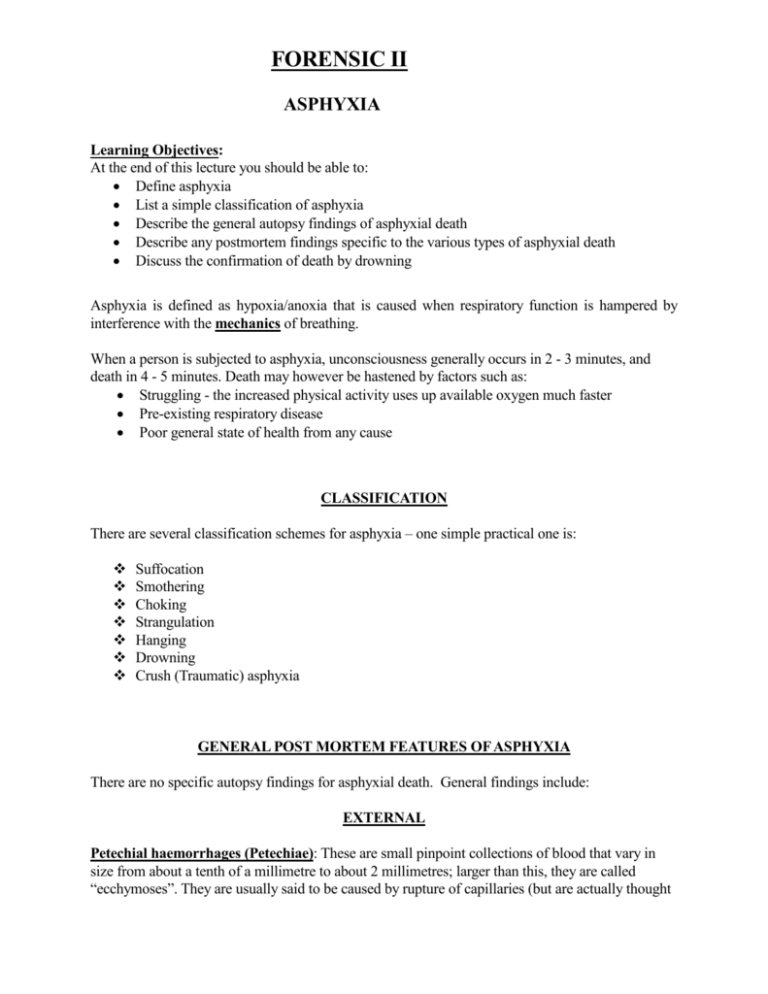
FORENSIC II ASPHYXIA Learning Objectives: At the end of this lecture you should be able to: Define asphyxia List a simple classification of asphyxia Describe the general autopsy findings of asphyxial death Describe any postmortem findings specific to the various types of asphyxial death Discuss the confirmation of death by drowning Asphyxia is defined as hypoxia/anoxia that is caused when respiratory function is hampered by interference with the mechanics of breathing. When a person is subjected to asphyxia, unconsciousness generally occurs in 2 - 3 minutes, and death in 4 - 5 minutes. Death may however be hastened by factors such as: Struggling - the increased physical activity uses up available oxygen much faster Pre-existing respiratory disease Poor general state of health from any cause CLASSIFICATION There are several classification schemes for asphyxia – one simple practical one is: Suffocation Smothering Choking Strangulation Hanging Drowning Crush (Traumatic) asphyxia GENERAL POST MORTEM FEATURES OF ASPHYXIA There are no specific autopsy findings for asphyxial death. General findings include: EXTERNAL Petechial haemorrhages (Petechiae): These are small pinpoint collections of blood that vary in size from about a tenth of a millimetre to about 2 millimetres; larger than this, they are called “ecchymoses”. They are usually said to be caused by rupture of capillaries (but are actually thought to be due to rupture of small venules) due to an acute rise in venous pressure. They occur most commonly in areas where the vessels are least supported – in this case the face – especially the eyelids, the conjunctivae and sclera. It is often said that petechiae are typical findings in asphyxial deaths, but this is NOT true. Their presence is highly variable and they are common non-specific autopsy findings. They are most commonly seen in asphyxial death related to compression of the neck or chest leading to increased venous pressure in the head. (See picture of conjunctival petechiae: http://medlib.med.utah.edu/WebPath/FORHTML/FOR125.html) Lividity/Congestion/Oedema/Cyanosis: Increased venous pressure leads to congestion and oedema of tissues (especially the face) and marked lividity. Cyanosis of the skin may be profound due to the high content of deoxygenated blood. INTERNAL The increase in venous pressure associated with asphyxia (due to obstructed venous return and/or impaired respiratory movements) causes generalized organ congestion +/- oedema. The blood is very dark (cyanosed). There is usually dilatation and engorgement of the right side of the heart. The lungs are congested and oedematous and there may be petechiae in serous membranes (pleurae, pericardium), meninges and thymus. The “classical” features of asphyxia at autopsy may not be seen in some deaths which appear to have occurred in an “asphyxial” setting because of: 1) Vagal inhibition (vagal reflex cardiac arrest): This may occur in any kind of asphyxial death but notably occurs in strangulation (especially the manual type). Violent stimulation of the parasympathetic nervous system (via the vagus nerve) slows the heart rate and leads to abrupt cardiac arrest. Vagal inhibition may be caused by compression of the vagus in the neck, compression of the larynx, a blow to the abdomen, the shock of cold water on the skin in sudden immersion etc. 2) Putrefaction: It must be noted that asphyxial signs are very striking in fresh bodies only. They disappear progressively with the passage of time and as a result of putrefaction. SUFFOCATION True suffocation (also called environmental suffocation) occurs when there is insufficient oxygen in the local atmosphere, usually in cases where the victim is trapped in a small, unventilated space e.g. trapped in a cellar or mine, sealed in a trunk or safe etc. Death usually occurs slowly and there are no specific autopsy findings. As a rule, petechiae are absent. Page 2 of 6 SMOTHERING Smothering and suffocation are often used interchangeably, but the term “smothering” is best used for that form of asphyxia in which the nose and mouth are obstructed e.g. by a hand, paper, clothes, pillow, plastic bag etc. Gagging people to keep them quiet may lead to smothering. Signs of asphyxia are commonly absent or are only slight, and because marks of injury may be few—if any at all— homicidal smothering may be difficult to diagnose. Overlaying is the accidental death by smothering of young children by adults sleeping with them. In the U.K. it is a criminal offence for an adult over 16 years who is drunk to have a child under 3 in bed with him (or her) because of the danger of overlaying. CHOKING This is due to blockage of the internal air passages, usually by foreign material e.g. inhaled vomit, blood, food particles - especially fruit seeds in children, the tongue in comatose patients etc. At autopsy the features of asphyxia are usually well developed, and the offending foreign material is demonstrated in the airway. (This link shows a picture of a choking death due to pills! http://www.pathguy.com/bryanlee/pills.htm) STRANGULATION Death by strangulation is usually homicidal but less commonly may be accidental or suicidal. Strangulation is due to constriction of the neck by a force other than the weight of the body. One may use a ligature, but the hands may also be used (manual strangulation or “throttling”). The ligature mark is usually at a lower level and more horizontal than in hanging and is usually located in the mid-larynx region i.e. at about the level of the thyroid cartilage. The mark is usually less prominent than in hanging, especially if a soft ligature is used. However, if a narrow wire is used, the mark may be deep and the skin may even be cut. Postmortem Findings The face is markedly swollen and cyanosed with bulging eyes and a protruding tongue. Petechial haemorrhages are often seen. The skin shows a constriction mark from the ligature or bruises from the fingers (in cases of throttling). There is haemorrhage and bruising of the neck muscles. Fractures of the larynx may occur—especially in cases of manual strangulation—particularly of the superior cornu of the thyroid cartilage and/or the greater cornu of the hyoid bone. The lungs are oedematous and congested. It is obvious that throttling can only be homicidal in nature. Attempted self-throttling would be selfdefeating because the hands would loosen their grip when unconsciousness supervenes. Suicidal strangulation is possible but uncommon. It may be achieved by using a tourniquet mechanism or adhesive ligatures, e.g. Velcro-type bands (http://www.suicidemethods.net/pix/asphyx4.htm). Accidental strangulation does occur e.g. from clothing such as a necktie or scarf becoming caught in moving machinery. Page 3 of 6 HANGING The neck is constricted by a ligature and the constriction force is provided by the victim's body weight. Hanging is usually suicidal, but less commonly, may be accidental. Cases of homicidal hanging are unusual. Note that suspension of the body in fatal hanging does not have to be complete – one may die from hanging with only a part of the body being suspended. Hanging can occur in the sitting or slumped position, where the suspension point is a door knob or something at a similarly low level. Causes of death in hanging Suicidal (Non-judicial) 1) Asphyxia - due to compression of the larynx and/or blocking of the air passages by the root of the tongue pressing against the pharynx. 2) Cerebral hypoxia/anaemia - due to carotid artery compression 3) Vagal inhibition 4) A combination of any of the above Postmortem Findings These are similar to those seen in strangulation except that fractures of the laryngeal cartilages are not as common. The ligature mark on the neck tends to be at a higher level than in strangulation and rises to a suspension point (inverted V shape) behind or under one ear, or at the back of the head. As in strangulation, the ligature mark may be absent if the ligature material is soft (eg a bed sheet), or where the deceased was cut down shortly after hanging him/herself, or where the body is decomposed. Pictures of hanging: (a) ligature in situ, http://www.pathguy.com/hangin2a.jpg (b) ligature removed, http://www.pathguy.com/hanging3.jpg) (c) hanging with suspension point, http://www.pathguy.com/lectures/hang3.jpg, http://www.pathguy.com/lectures/hung1.jpg Judicial The sudden braking of the body by the noose after a drop of several feet leads to fracture and/or dislocation of the cervical spine–either at the atlanto-occipital joint, the atlanto-axial joint, or in the mid-cervical portion of the spine–with high spinal cord or brain stem injury leading to sudden death. The circumstances of each hanging must be carefully examined to determine whether death was suicidal, accidental or homicidal. Page 4 of 6 (Auto-erotic asphyxial deaths may involve elements of strangulation or hanging. They usually involve males and occur in isolated or secluded sites. There may be evidence of transvestitism, bondage, mirrors, cameras, etc.) DROWNING This is defined as asphyxial death due to submersion in water or other fluid. Postmortem findings External Signs of submersion e.g. sodden clothing, wrinkled waterlogged skin (especially of the hands and feet) etc. Signs suggestive of drowning i.e. indications that the victim was alive when he/she entered the water e.g. objects from the water or shore/river bank clutched in the hand e.g. weeds, gravel, sand etc. Persistent, fine, white froth at nostrils and mouth Signs of asphyxia e.g. petechiae are NOT usually seen. Internal Fine froth lines the trachea, bronchi and distal air passages. Voluminous, sodden, heavy lungs, which may be indented by the ribs; pressure from a finger will leave an indentation. Water in the stomach (seen in up to 70% of cases). Mechanism of Drowning Death is primarily due to hypoxia by exclusion of air from the lungs, but is largely due to electrolyte imbalance and/or haemolysis from the effects of inhaled water on the blood. When water is inhaled into the lungs, the respiratory movements mix it with mucus and surfactant producing the fine stable froth that is characteristically seen. Fresh Water Drowning The hypotonic water enters the blood via the pulmonary capillary bed leading to hypervolaemia, haemodilution, haemolysis and electrolyte imbalance which serve to hasten death. Salt Water Drowning The hypertonic seawater extracts water from the blood in the pulmonary circulation leading to haemoconcentration and electrolyte imbalance. The latter is not as severe because there is neither haemolysis nor hypervolaemia and therefore death in salt water drowning may be 4 to 5 times slower than in fresh water drowning. N.B. A person may be said to have died from drowning up to 24 hours after having been immersed in water! Having survived the actual immersion, it is possible to die later from any or a combination of the following: pulmonary (alveolar) damage – adult respiratory distress syndrome (ARDS), electrolyte imbalance, hypoxic brain injury etc. "Dry Drowning" This refers to submersion in water leading to sudden death without the Page 5 of 6 typical features of drowning being seen. The 2 causes postulated for this are: (i)Vagal inhibition – such as might occur in sudden submersion in cold water, or falling unexpectedly into water. (ii)Laryngospasm – sometimes, even in expert swimmers, entry of water into the larynx may lead to sudden, severe laryngeal spasm and an asphyxial death, effectively due to choking! In such a case, one might see signs of asphyxia without typical features of drowning. CONFIRMATORY TESTS FOR DROWNING 1) Diatom identification/analysis Diatoms are microscopic, unicellular algae with heat and acid resistant shells of silica and are found in most bodies of fresh or seawater. At autopsy, specimens from liver, kidney, brain and bone marrow can be digested with concentrated mineral acids. If diatoms are found, this provides strong evidence of drowning, as in order for these organisms to have reached the aforementioned organs, they would have had to be absorbed from the pulmonary vascular bed and carried to these organs by a dynamic systemic circulation. Note that the lung tissue itself is not used to test for diatoms because these might be present in cases of mere submersion of a previously deceased person due to passive influx of water into the lungs. A positive diatom test is especially valuable where putrefaction has rendered other methods of diagnosis useless. 2) Middle ear haemorrhages are characteristic (though not specific) of death by drowning. They are thought to be related to barometric pressure. 3) Biochemical tests e.g. in fresh water drowning, blood from the left heart will be more dilute than that from the right; and the reverse will occur in salt water drowning. These tests are relatively nonspecific. CRUSH (TRAUMATIC) ASPHYXIA This is caused by compression of the thorax/abdomen by a heavy weight e.g. a collapsed building, overturned vehicle, or stampeding spectators e.g. at a crowded stadium. Respiratory movements are prevented and blood is forced into the head and neck. This produces a characteristic deep engorgement and cyanosis with large petechiae in the head, neck and upper body. Some cases of overlaying (see “Smothering”) may have a component of crush asphyxia. CTE/cte/Jan 2007 Page 6 of 6
